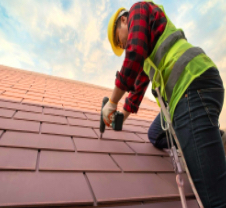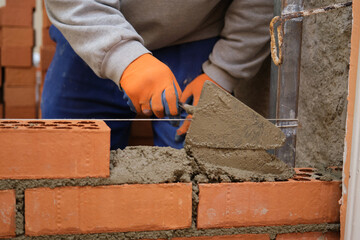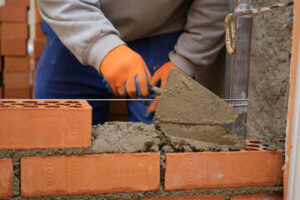 A good roof protects the interior of a building from rain, snow, sunlight, and extreme temperatures. The roof structure may be flat, pitched, vaulted, or domed. A bad roof can cause leaks and damage the inside of a home. It can also contribute to high energy bills. A well-installed and maintained roof can last for decades. For more information visit Roofers Round Rock.
A good roof protects the interior of a building from rain, snow, sunlight, and extreme temperatures. The roof structure may be flat, pitched, vaulted, or domed. A bad roof can cause leaks and damage the inside of a home. It can also contribute to high energy bills. A well-installed and maintained roof can last for decades. For more information visit Roofers Round Rock.
The durability of roofing materials is important when determining whether to use asphalt shingles, wood shakes, slate tiles, or metal. Durable roofs can withstand rain, snow, sunlight, strong winds, and extreme temperatures. Some of the longest-lasting roofing materials are concrete and clay tile, which also provide superior fire resistance to other natural products such as wood shakes or asphalt shingles. Other natural roofing materials include cut turf (modern ones known as green roofs, traditional ones called sod roofs) and adobe. Felt underlayment is often required to maintain a roof’s fire rating.
Many leaks in roofs occur around penetrations such as skylights or plumbing vents. Replacing or fixing flashing at these points can prevent future problems. Most roof leaks can also be controlled by replacing or repairing damaged gutters.
While the roof is one of the most crucial components of residential and commercial properties, its aesthetics is often overlooked. While functionality and durability always take precedence, homeowners and occupants will derive great satisfaction from a visually appealing roof that complements the rest of the structure. Whether enhancing the sleek lines of a modern home, the rustic charm of a cottage, or even contributing to energy efficiency in a historic landmark, the right roofing materials can add to a building’s overall aesthetic and help it stand out.
Many roofing materials come in various colors, and certain shingle patterns like herringbone or staggered create a visual interest that helps to round out a home’s overall look from the curb. There are also roofing options that offer both beauty and sustainability by combining the elements of green roofing or solar panels with traditional materials like slate or wood.
The materials and construction of roofs vary widely, dictated by technical, economic, or aesthetic considerations. Many modern roofing systems are designed for energy efficiency, reducing the heat entering buildings and moderating indoor temperatures.
Roofs made of light colors or coated with reflective pigments reflect the sun’s rays, keeping the attic cooler and allowing excess heat to dissipate. Adding above-sheathing ventilation (ASV), a common feature in tile roof installations also decreases energy costs by creating an air space between the tiles and the sheathing that reduces heat transfer and allows excess heat to vent out of the attic.
As oil, coal, and natural gas prices continue to increase, and climate change continues to alter climatic conditions, engineers are looking for ways to reduce heating and cooling costs by using more energy-efficient building materials. A roof’s energy efficiency can play a major role in managing a home’s utility costs, so homeowners are encouraged to choose the most energy-efficient building materials when they do renovation projects. This can impact their monthly utility bills and save them thousands of dollars.
A roof damaged by water can also allow pests to enter the home. Bird droppings, for example, contain acid that can damage shingles and even cause them to break apart. In addition, the shingles can become soft and rot due to algae, moss, or lichens. These fungus-like organisms are difficult to remove from the shingles and will reappear as soon as moisture returns.
When the shingles are weakened, they can be torn off by wind and become airborne. This debris can then fall and damage the wood framing of a building, as well as other components like siding and windows. The shingle debris can also clog gutters and prevent them from performing properly.
Clogged gutters can cause the water to back onto a roof and even leak into the home. It can also lead to mold formation, rotting wood, and other problems. Regular cleaning and maintenance of the roof can prevent this from happening and help protect the structure of the building as well as its interior.
A professional cleaning service can use a low-pressure washer to clean the roof without causing damage. This method is also safer for the environment, as it reduces the amount of runoff that can be contaminated with chemicals or other pollutants.
A professional can also remove any debris that is clogging the gutters. They can also trim any overhanging trees that could fall onto the roof during a storm or a heavy snowfall. A roof can protect the entire house by keeping the gutters free of debris and ensuring they are working properly. It can also prevent the formation of fungus, algae, and other organisms that clog the gutters and affect roof performance.
Roof cleaning preserves a roof warranty and helps homeowners avoid paying for expensive roof repairs. This is because moss and lichen retention causes moisture, which can damage a roof. This can void some roof warranties and even homeowner’s insurance coverage if left unchecked. Regularly scheduled roof cleanings help prevent these issues, thus protecting a home’s value and curb appeal.
Additionally, power washing is not recommended for a roof as it can remove a significant amount of the ceramic-coated granules from a shingle and cause serious damage to the siding of a house. Our soft wash roof cleaning process cleans the roof without high pressure, preserves the roofing materials, and helps maintain a roof warranty.
A clean-looking roof can detract from a home’s resale value and may not meet the standards of a neighborhood’s homeowner’s Association (HOA). Keeping a roof regularly cleaned prevents the need to spend money on a new roof sooner than necessary and can help satisfy HOA requirements.
Whether you’re looking to sell your home or want to improve your curb appeal, it’s important to clean the exterior of your property regularly. Regular siding, sidewalk, and window cleanings will show guests and passersby that you care about your space and are a responsible homeowner.
However, one area that is often overlooked when it comes to improving curb appeal is the roof. A dirty, stained, or streaked roof can leave a bad impression on visitors and detract from the overall appearance of your home or commercial building.
The good news is that you can easily elevate your curb appeal by having your roof cleaned. A professional cleaning will remove dirt, moss, algae, and other debris that can cause your roof to look dull and unattractive. The result will be a beautiful, shiny roof that will elevate your home’s curb appeal and give it an instant facelift.
Additionally, a regularly cleaned roof will help to preserve the resale value of your home or business. Many prospective buyers will be turned off by a dirty or damaged roof, which can lead to expensive repairs and replacements down the road. Keeping your roof in pristine condition can avoid these costly expenses and still get the most out of your investment.
In addition to increasing your curb appeal, a clean roof can also improve your energy efficiency. Dirty roofs can trap heat and increase your cooling costs, while a clean roof reflects the sun’s rays instead of absorbing them. If you’re interested in improving your curb appeal and preserving the value of your home or business, contact Kingwood Pressure Washing today to learn more about our roof cleaning services.
We use a safe and effective low-pressure washing method that eliminates stains, streaks, moss, algae, and other debris without damaging the shingles. We offer residential and commercial roof cleaning and can even clean your gutters while we’re on site. Our process is fast, affordable, and guaranteed to leave your roof clean and beautiful.
Many roof warranties require proper maintenance, including regular cleaning. Refrain from cleaning your roof to avoid these warranties, which can lead to costly repairs and replacements. A thorough, non-pressure cleaning by a qualified professional can protect the warranty on your roofing materials and help you avoid expensive repair bills.
Mildew, mold, and mildew that accumulate on a roof can release spores into the air, posing health risks for your family. Cleaning your roof regularly can keep these spores from entering the home, improving indoor air quality and reducing respiratory issues.

